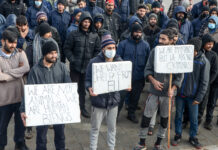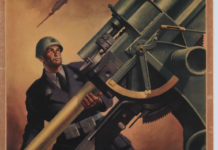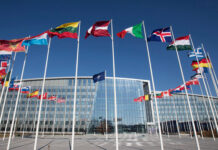Latest Developments
The Republic of Nagorno-Karabakh, or Republic of Artsakh, is now a state entity that can be spoken of in the past tense. Its population is no longer what it used to be until September 2023 when, after the Azerbaijani blockade of the Lachin corridor lasting for months, Azerbaijani forces swiftly overwhelmed the enclave’s defense troops and conquered the region in 24 hours of fighting, leading to a mass exodus of the Armenian population. In 2020, during the Second Nagorno-Karabakh War, Azerbaijan gained an advantage with an offensive that reclaimed part of the territory around the enclave. After 6 weeks of fighting, Russian peacekeeping forces deployed to monitor the new Moscow-mediated ceasefire were supposed to ensure safe passage through the so-called Lachin corridor separating Nagorno-Karabakh from Armenia.
The cessation of hostilities that began in November 2020 had once again quieted a conflict that has remained unresolved since 1991. And it did so once again without laying solid foundations for a lasting peace process. In 2022, new fighting erupted between Armenian and Azerbaijani troops, while internationally things were changing: Moscow, traditional ally of Yerevan, did not appreciate Armenia’s cautious stance towards the war in Ukraine. This facilitated Baku’s decision to consider a new decisive intervention, which began on September 19, 2023. Characterized by bombings, what is described as an anti-terrorist operation began.
The conflict practically lasted only one day. With the mediation of the Russian Peacekeeping Command in the region, an agreement was reached on September 20 to establish a cessation of hostilities. Subsequently, residents of Stepanakert often reported violations of the ceasefire. In this climate, on September 21, Azerbaijan met with representatives of Nagorno-Karabakh in Yevlax, leading to the agreement on September 28, declaring that the Republic of Artsakh would cease to exist as an independent state on January 1, 2024. As a consequence of the agreement, there was a mass exodus, practically emptying the enclave: on October 5, 2023, Human Rights Watch reported that over 100,000 Armenians (nearly the entire population of the region) had left those territories. The entire Azerbaijani operation, portraying a picture of aggression and ethnic cleansing, occurred in almost total silence from the international community.
What are they fighting for
In Nagorno-Karabakh, fighting has always been for control of a relatively confined territory nestled among the mountains of the southern Caucasus: not particularly rich, but strategically located in a region increasingly central to energy distribution between Europe and Asia. The origins of the conflict between Armenians and Azerbaijanis date back to the period of the Soviet Union’s collapse when internal borders separating populations in the area suddenly turned into state delineations. The birth of the independent Republics of Armenia and Azerbaijan in 1991, however, only fueled a clash that had already been explosive since 1989 when the Armenian majority of Nagorno-Karabakh endorsed, through a referendum, the decision of the Parliament to align with Armenia. Ethnic tensions culminated in the First Nagorno-Karabakh War, fought between 1991 and 1994, which caused more than 25,000 casualties and hundreds of thousands of displaced persons. The end of the fighting, achieved through a ceasefire signed by both parties in Bishkek (Kyrgyzstan) in May 1994, ensured a delicate truce that lasted 26 years. The de facto leaders of Nagorno-Karabakh declared independence, and Armenian forces took control of 7 Azerbaijani districts around the enclave. Hostilities between the two states have never definitively ceased: they instead led to the Four-Day War in 2016, the Second War in 2020, and the expulsion of Armenians from the enclave in 2023.
General Overview
Until September 2023, Nagorno-Karabakh was an enclave inhabited by an Armenian majority within the territory of Azerbaijan. Ethnic issues have been one of the contributing factors to the long-standing conflict between Azerbaijan and Armenia fought in this region. Tensions first erupted in 1991, and between 1992 and 1994, the First Nagorno-Karabakh War took place. The status quo following the ceasefire in May 1994 favored Yerevan: emerging victorious from the war, it controlled the enclave and 7 adjacent districts, which Baku claimed control over. Years of negotiations mediated by the Minsk Group (an organization of the Organization for Security and Cooperation in Europe, OSCE), which has been mandated since 1994 to facilitate an agreement between the parties, proved futile.
The escalating hostilities between the two states culminated in the Four-Day War in April 2016, followed by violent clashes at the border between the two states in July 2020, and finally, in the Second Nagorno-Karabakh War between September and November 2020. According to a study by the Stockholm International Peace Research Institute (SIPRI), the imminent war was signaled by the military expenditure data of Armenia and Azerbaijan in 2020: respectively 4.9% and 5.9% of GDP, about 3 percentage points higher than the global average. Another element highlighted by the same study was the asymmetry in the military investment of the two states. From 2011 to 2020, Baku invested about 8 times more than Yerevan in military spending, mainly sourcing from Russia (60%), Israel (around 30%), Belarus (7%), and Turkey (3%). In contrast, Armenia relied mainly on Russia (90%) and Jordan (5%).
Despite being one of the three permanent members of the Minsk Group and being bound to Yerevan by the Collective Security Treaty Organization (CSTO), Russia has always maintained a balancing position in the conflict, being the major arms supplier to both belligerent parties. However, while Russia supplied Armenia at reduced prices or in the form of military aid because the two states are part of a broader military cooperation, Azerbaijan usually paid full price for Russian arms, making it a partner that Moscow found difficult to relinquish.
Thus, while Russia found itself once again at the center of the Caucasus scene, and Azerbaijani President Aliyev was able to benefit from popular support following the victory, Armenia faced one of the most severe political crises in its history in 2020. Pashinyan’s government, in its third term since 2018, faltered. Violent protests erupted repeatedly in the capital Yerevan demanding the end of the government, accused of betraying the country by signing a ceasefire that resembled more of an unconditional surrender. Protests recurred in 2023 following the Armenian exodus from the enclave by Baku. On the other hand, the military superiority demonstrated by Azerbaijani forces left little room, in 2020 as in 2023, for Armenian leadership to hope for a war outcome that could advance claims at the negotiating table. The new balance emerging after the latest ceasefire also left a series of issues suspended, including the future of Armenian prisoners of war still in Azerbaijani prisons, that of the displaced, and the demarcation of new national borders.
Lastly, Russia’s invasion of Ukraine in 2022 and Yerevan’s distancing from the Ukrainian dossier changed the dynamics of relations between the two states and favored Baku’s position. 2023 marked a watershed, obliterating the Nagorno-Karabakh issue, the major dispute between Armenians and Azerbaijanis. However, the manner and effects of the clashes in October 2023, culminating in the surrender of the self-proclaimed Republic of Artsakh, do not promise easy future relations between Armenia and Azerbaijan. The situation is also influenced by the positions of Moscow and Ankara, among the main actors in the region.
Key figure or organisation: The character of Pashinyan and the Ukrainian dossier
Although Armenia had abstained from voting on the condemnation of the Russian aggression against Ukraine at the UN (March 2022), its position has evolved over time. In the summer of 2023, there was uproar over a statement by Armenian Prime Minister Nikol Pashinyan, explaining that Armenia is not an ally of Russia in the war in Ukraine and is instead concerned about the impact of that crisis on its relations with other countries. Months earlier, Pashinyan had also feared that the massive deployment of Russian military forces in Ukraine would weaken assistance to Yerevan. Russia does not take Yerevan’s new stance well: Armenia has always been its protégé, and the small former Soviet state in the southern Caucasus region has close economic and security ties with Moscow, strengthened by the decades-long dispute with neighboring Azerbaijan over the Nagorno-Karabakh territory.
FOCUS 1 – The Sultan’s Pride
Already on September 25, 2023, thousands of Armenians from Nagorno-Karabakh had begun to leave their homes. Within a few days, the Armenian enclave in Azerbaijan was emptying out amid the despair of many and the appreciation of others. Among the first to congratulate his Azeri counterpart, Ilham Aliyev, for his assistance in “stabilizing the region” was the Turkish President, Recep Tayyip Erdogan, the autocrat of Ankara whom many call the “Sultan.” A report by Euronews from late September, when the Armenian exodus had just begun, showed Erdogan “proud that Azerbaijan had carried out the military operation in Nagorno-Karabakh quickly and with the utmost respect for civilians,” aimed at reintegrating the special administrative region into Azerbaijan with a (former) Armenian majority population. During a visit to the Armenian exclave of Nakhchivan for the inauguration of a new gas pipeline and a military complex, Erdogan congratulated Aliyev for opening “new possibilities for normalization of balances” in the region. Turkey is a historic ally of Azerbaijan, and Aliyev himself thanked Erdogan for the support received from Ankara in the “anti-terrorism operation” that cost the lives of about 200 people.
FOCUS 2 – Nakhchivan as the main goal
With the Azerbaijani victory in the recent offensive, the discussion about the “Zangezur corridor” resurfaces, referring to the portion of Armenian territory approximately 30 km wide that separates Azerbaijan from its exclave: the area of Nakhchivan, which is part of Azerbaijan but is located within Armenia, bordering Iran and Turkey. Nakhchivan became a separate exclave from Azerbaijani lands after the Soviet occupation of the South Caucasus region in 1920. As an autonomous republic, it represents about 6% of Azerbaijan’s territory and is inhabited by 460,000 people, mostly Azerbaijanis but also of Russian origin.























